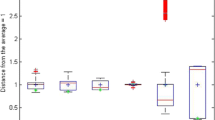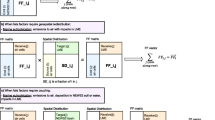Abstract
Background, Aims and Scope
Several authors have shown that spatially derived characterisation factors used in life cycle impact assessment (LCIA) can differ widely between different countries in the context of regional impact categories such as acidification or terrestrial eutrophication. Previous methodology studies in Europe have produced country-dependent characterisation factors for acidification and terrestrial eutrophication by using the results of the EMEP and RAINS models and critical loads for Europe. The unprotected ecosystem area (UA) is commonly used as a category indicator in the determination of characterisation factors in those studies. However, the UA indicator is only suitable for large emission changes and it does not result in environmental benefits in terms of characterisation factors if deposition after the emission reduction is still higher than the critical load. For this reason, there is a need to search for a new category indicator type for acidification and terrestrial eutrophying in order to calculate site-dependent characterisation factors. The aim of this study is to explore new site-dependent characterisation factors for European acidifying and eutrophying emissions based on accumulated exceedance (AE) as the category indicator, which integrates both the exceeded area and amount of exceedance. In addition, the results obtained for the AE and UA indicators are compared with each other.
Methods
The chosen category indicator, accumulated exceedance (AE), was computed according to the calculation methods developed in the work under the United Nations Economic Commission for Europe (UNECE) Convention on Long-range Transboundary Air Pollution (LRTAP). Sulphur and nitrogen depositions to 150x150 km2 grid cells over Europe were calculated by source-receptor matrices derived from the EMEP Lagrangian model of long-range transport of air pollution in Europe. Using the latest critical load data of Europe, the site-dependent characterisation factors for acidification and terrestrial eutrophication were calculated for 35 European countries and 5 sea areas for 2002 emissions and emissions predicted for 2010. In the determination of characterisation factors, the emissions of each country/area were reduced by various amounts in order to find stable characterisation factors. In addition, characterisation errors were calculated for the AE-based characterisation factors. For the comparison, the results based on the use of UA indicator were calculated by 10% and 50% reductions of emissions that corresponded to the common practice used in the previous studies.
Results and Discussion
The characterisation factors based on the AE indicator were shown to be largely independent of the reduction percentage used to calculate them.. Small changes in emissions (≤100 t) produced the most stable characterisation factors in the case of the AE indicator. The characterisation errors of those characterisation factors were practically zero. This means that the characterisation factors can describe the effects of small changes in national emissions that are mostly looked at in LCAs. The comparison between country-dependent characterisation factors calculated by the AE and UA indicators showed that these two approaches produce differences between characterisation factors for many countries/areas in Europe. The differences were mostly related to the Central and Northern European countries. They were greater for terrestrial eutrophication because the contribution of ammonia emission differ remarkably between the two approaches. The characterisation factors of the AE indicator calculated by the emissions of 2002 were greater than the factors calculated by the predicted emissions for 2010 in almost all countries/sea areas, due to the presumed decrease of acidifying and eutrophying emissions in Europe.
Conclusions
and Recommendations. In this study, accumulated exceedance was shown to be an appropriate category indicator in LCIA applications for the determination of site-dependent characterisation factors for acidification and terrestrial eutrophication in the context of integrated assessment modelling. In the future, it would be useful to calculate characterisation factors for emissions of separate parts of large countries and sea areas in Europe. In addition, it would also be useful to compare the approach based on the AE indicator with the method of the hazard index, as recommended in the latest CML guidebook.
Similar content being viewed by others
Author information
Authors and Affiliations
Corresponding authors
Rights and permissions
About this article
Cite this article
Seppälä, J., Posch, M., Johansson, M. et al. Country-dependent Characterisation Factors for Acidification and Terrestrial Eutrophication Based on Accumulated Exceedance as an Impact Category Indicator (14 pp). Int J Life Cycle Assessment 11, 403–416 (2006). https://doi.org/10.1065/lca2005.06.215
Received:
Accepted:
Published:
Issue Date:
DOI: https://doi.org/10.1065/lca2005.06.215




